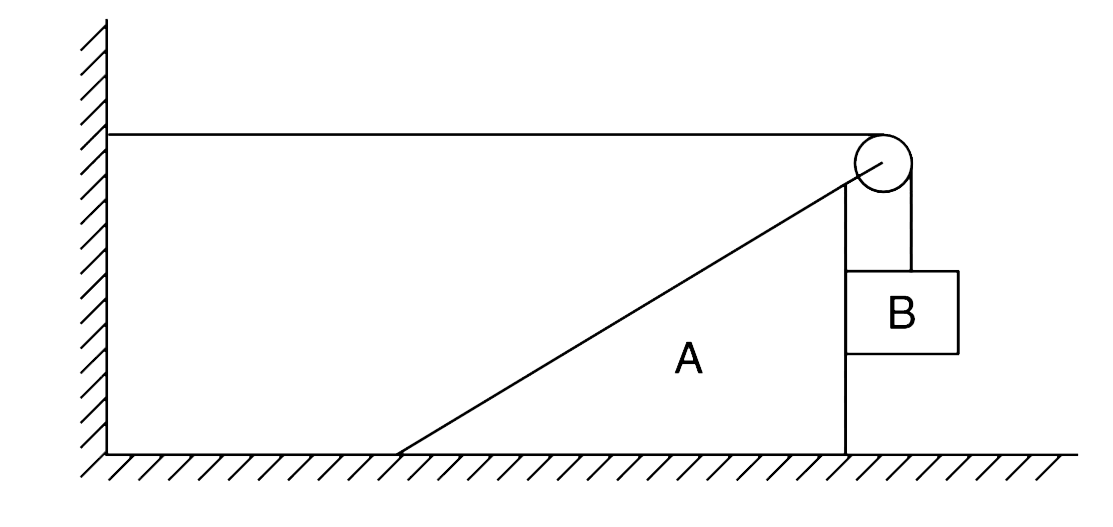_2019_CBT8_E01_025_Q01.png)
Two blocks A and B are being accelerated by forces shown in figure with accelerations →a1 and →a2 respectively. The value of |→a1−→a2|
45
85
54
58
The correct Answer is:A, B, C
Step by step video, text & image solution for Two blocks A and B are being accelerated by forces shown in figure with accelerations veca_(1) and veca_(2) respectively. The value of |veca_(1)-veca_(2)| by Physics experts to help you in doubts & scoring excellent marks in Class 12 exams.
Topper's Solved these Questions
Similar Questions
In the system shown in figure, all surfaces are smooth, pulley and strings are massless. Mass of both A and B are equal. The system is released from rest.

(a) Find the →aA.→aB immediately after the system is released. →aAand→aB are accelerations of block A and B respectively.
(b) Find →aA immediately after the system is released.View SolutionIf |→a|=∣∣→b∣∣=∣∣→a+→b∣∣=1 then find the value of ∣∣→a−→b∣∣
View Solution
Knowledge Check
- Question 1 - Select One
Two rough blocks A and B ,A placed over B move with acceleration →aA and →aB veclocities →v(A) and →vB by the action of horizontal forces −→FA and −→FB, respectively. When no friction exsits between the blocks A and B,
 AvA=vBBaA=aBCBoth (a) and (b)DNone of the Above
AvA=vBBaA=aBCBoth (a) and (b)DNone of the Above - Question 2 - Select One
If →a and →b are two non-collinear unit vectors and if |→a1+→a2|=√3, then the value of (→a1−→a2)(2→a1+→a2) is:
A2B3/2C1/2D1 - Question 3 - Select One
When we analyse the projectile motion from any accelerated frame O as →ro,→uo and →ao respectively, express the following terms, →rpO+→ap−→rO,→upO=→up−→uO and →apO=→ap−→aO
where P stands for projectile. Then using the following kinematical equations of the projectile (For constant acceleration) relative to the accelerating frame ,we have →SpO=→upOt+12→apOt2,→vpO
=→upO+→apOt and v2pO=u2pO+2→a.→spO
Using the above expressions, anwer the following
question:A projectile has initial velocity v0 realtive to the large plate which is moving with a constant upward acceleration a.
Refering to Q.1, velocity of the projectile relative to B ofter some time
 A<v0at an angleθ<θ0B>v0at an angleθ>θ0C>v0at an angleθ=θ0Dv0at an angleθ=θ0
A<v0at an angleθ<θ0B>v0at an angleθ>θ0C>v0at an angleθ=θ0Dv0at an angleθ=θ0
If a and b are perpendicular vectors with |→a|=2,∣∣→b∣∣=3 and →c×→a=6 , then the least value of |→c−→a|
View SolutionIt is given that ∣∣→A1∣∣=2,∣∣→A2∣∣=3and∣∣→A1+→A2∣∣=3
Find the value of (→A1+→A2).(2→A1−3→A2)View SolutionWhen we analyse the projectile motion from any accelerated frame O as →ro,→uo and →ao respectively, express the following terms, →rpO+→ap−→rO,→upO=→up−→uO and →apO=→ap−→aO
where P stands for projectile. Then using the following kinematical equations of the projectile (For constant acceleration) relative to the accelerating frame ,we have →SpO=→upOt+12→apOt2,→vpO
=→upO+→apOt and v2pO=u2pO+2→a.→spO
Using the above expressions, anwer the following
question:A projectile has initial velocity v0 realtive to the large plate which is moving with a constant upward acceleration a.
Which of the following remains equal for the observers A and B?
 View Solution
View SolutionThe equation of the plane contaiing the lines →r=→a1+λ→b and →r=→a2+μ→b is
View SolutionLines →r=→a1+λ→b1and→r=→a2+s→b2 will lie in a Plane if
View Solution

